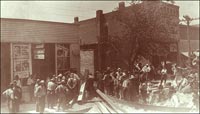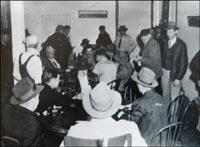
|
|
|
Search our site
Check these out   Do you have an entertaining or useful blog or personal website? If you'd like to see it listed here, send the URL to leon@pawneerock.org. AnnouncementsGive us your Pawnee Rock news, and we'll spread the word. |
Too Long in the WindWarning: The following contains opinions and ideas. Some memories may be accurate. -- Leon Unruh. Send comments to Leon December 2007Cucumber dill dip mix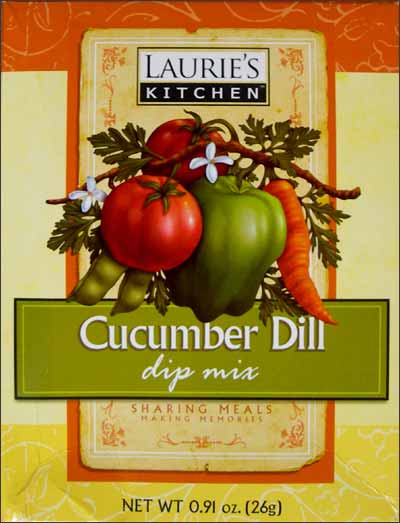
[December 31] A couple of months ago, a friend from work gave me a hyacinth bulb, rough and purplish and looking like a tired onion, with instructions to put it in a narrow-neck bottle with water up to the bottom of the bulb. "You'll have flowers by Christmas," she said.
And that's the way the year went. Two or three of months invested in a project here and there, and success came as surely as if ordained by nature. For example, the trip we made on Biking Across Kansas required many hours of hard practice, but it was a backbone-building success and an adventure. Other pleasure came easily. In fact, one piece of it came as a Christmas present from sister Cheryl. Cheryl spent time at the Unruh grandparents' farm, just as I did, and she grew up smelling the dill weed that Grandma grew just off the porch. I have great affection for the scent and flavor, which I've mentioned in passing. So Cheryl, who was at Bluestem Farm and Ranch Supply in Emporia, tossed a box of Laurie's Kitchen cucumber dill dip mix into her shopping basket, wrapped it up, and mailed it to us. (I found out later that when my wife took the boys shopping after Christmas, young Nik broke out in laughter every now and then and mimicked my reaction to the gift: "Cucumber dill dip mix! Look at that!" Imagine the personal happiness I felt knowing that I had been made fun of in a Wal-Mart. On the other hand, Nik secretly learned to play "Happy Birthday" on his guitar so he could surprise me that night, and nothing tops a gift of that sort.) Until Christmas morning, I hadn't even known you could buy such a product. I had been mixing my own dillish delight: dill mixed with cream cheese and slivers of smoked salmon. In our stores, I shouldn't hope to find cucumber dill dip mix; it's hard enough to find okra. Yesterday I made the cucumber dill dip, adding the beloved flavoring (includes onion and garlic) to a cup of mayonnaise and a cup of sour cream and blending it. Everyone in the family tried it, even our young skeptics. For my wife, dill is just another flavor, and for the boys, it's a shame they aren't growing up with a dill plant in the yard. But maybe they have their own associations with halibut or pizza sauce or broccoli. We got many very nice and sometimes expensive gifts, but the dollar box of cucumber dill dip mix may be my favorite. I'm sure there's a moral in that conclusion, but I won't bore you with it. All in all, my year went well. There was hard work and rewards, and sometimes the living simply was easy. I hope yours went just as well, and if this past year didn't make you happy and prosperous, the next one is sure to do just that. Happy New Year, my friends. Rick Tutak and PR nicknames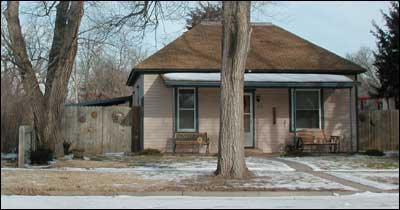 The Tutaks' former home on Santa Fe Avenue. [December 30] I watched Rick Tutak and his brothers from my front porch in the 1960s and '70s; they were a boisterous clan and always had friends over to talk in the yard or play football on sandy Santa Fe Avenue. Rick is the second brother, after Alan, and he precedes Kent and Ray. They're the sons of Stanley and Doris Tutak. Rick wrote yesterday: Grew up in Pawnee Rock my entire life and would not trade it for anything. Nobody was known by their real names, cause everyone had a nickname!!! See if you can figure out who was who: Tuk, Domple, Vernie, Biggy, Daylight, Greaser, Buff, RD, Beans, Diggs, Bugs, Gopher, Gil, Buck, Goofy, HS, BJ, Jake, Tub, Cricket, Cotton, Boo, Festus, Philly, Turdby, Marion, Squinty, Bub . . . kind of like "Cheers" . . . "Where everybody knows your name." I was the second son of Doris and Stanley Tutak and the best athlete of all 4 of us boys (ha). Dad ran the drug store for many years and always had an ongoing price war with Dale Hixon at the grocery store just two doors south!! We heard many stories about fishing on the river with all his friends and how Willard Wilson built the first dual engine combines in the area. The stories of the Legions' fish fries were very entertaining (if anybody else knows what I'm talking about?). Will never forget the great memories and ever-lasting friendships of growing up in "The Rock." Rodney Walker: Rodney Walker, who attended Pawnee Rock Junior High in the early 1980s, now is the police chief of Hennessey, Oklahoma. You may have driven through Hennessey; it's northwest of Oklahoma City, halfway between Enid and Kingfisher on U.S. 81. Rodney asked to be listed with the Friends of Pawnee Rock. The Paretskys: A couple of days ago, I mentioned Sara Paretsky and her new book, "Bleeding Kansas," wondering where in northeast Kansas the Paretsky family had come from. Cal Wiebe, a lawyer in Wichita and a friend since college, informs us that the Paretskys are from Lawrence. Sara's brother Jon is a staff attorney for the Kansas Court of Appeals, Cal wrote. A photo I like: No. 67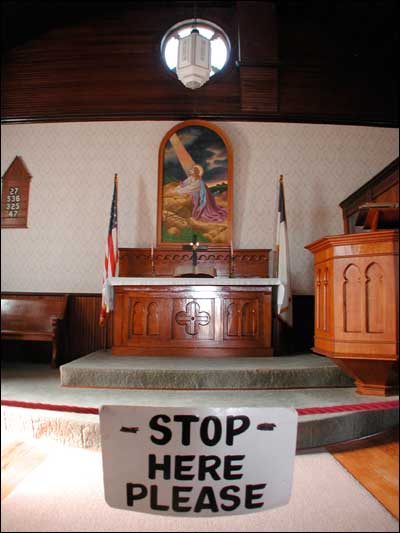
[December 29] The Barton County Historical Society Museum and Village lets its visitors touch a lot of objects; it's a great way to make a connection with the people and things that brought us to where we are. But the altar in the Lutheran church is off limits; I suspect it may be something people would love to touch a little too much. Once the staff got cleanliness next to Godliness, no one wanted to let it be spoiled. The church was moved here from its original site south of Albert. It was last used in 1964. The museum, with its frame buildings and metal sheds (and metal house), is a great half-day excursion when you're in Great Bend. It's just south of the river on U.S. 281. Reading and understanding[December 28] Wisdom and knowledge never seem to be handy when you need them, but Kay Steed is doing her best to make them available. You and I get the wisdom, and her granddaughter gets the knowledge. Kay sent this e-mail: "Reading the P.R. website and the talk of 'A Christmas Carol' reminds me of the hundreds of times I've read 'The Night Before Christmas' or had it read to me as a child. I didn't understand a lot of it, as a child, and this past week I had a chance to explain to my 5 yr. old granddaughter another puzzling line from the book. "'The moon on the breast of the new fallen snow, gave a luster of mid day to objects below.' We've had a full moon here all through Christmas and as I would look out, I could see just as if it was daytime. It is somehow hypnotic to be able to see so much in the middle of the night; however, I never saw a 'right jolly old elf.' "As I read the book now, though, I take the time to try to explain to the little ones what some of the wording means, because I think I was an adult before I fully understood them. "Just a thought; hope you and yours had a wonderful holiday. Happy New Year." Taking a lesson from Kay, I'll try to listen with my sons' ears this coming year and not assume they know what I'm talking about.
Sheila is celebrating her 97th birthday between Christmas and New Year's and might enjoy hearing from you, writes Jeanine Mull Haynes, passing along information from her dad, Keith. Sheila Schmidt Just regular folks: Sara Paretsky, a mystery writer who produced the V. I. Warshawski series, apparently is a native of northeastern Kansas and has decided to plant her next book there. "Bleeding Kansas," judging from the description on her site, saraparetsky.com, seems guaranteed to enhance Kansas' reputation as a refuge for flakes. I'm guessing that it'll be an entertaining book. An author you know: Check out Pawnee Rock expatriate Cheryl Unruh's poem about winter light. Lions and tigers and bears, oh-oh[December 27] When I read about Tatiana the Siberian tiger getting out of its cage in the San Francisco Zoo, I did what any Pawnee Rock native would do: I thought of the Brit Spaugh Zoo in Great Bend. Only when I was a grade-schooler did I imagine that the black panther or the bear or the coyote would slip out and maul me. Eventually I realized that those animals were in their cages to stay. Decades of Kansas animal husbandry and an iron foundry had developed unbreakable cages. Nothing could get out, and nobody could get in. Actually, nobody would want in those cages, because they stank. I'm sure the keepers did their best, but monkeys and big cats made it their lives' work to mark their personal spaces. I know the zoo has made some improvements recently, and it's probably much better now. As stinky as the zoo was, it didn't begin to compare to the December afternoon I spent with Dale Unruh fixing up his pig pens on his family's farm just this side of Dundee. Although the pigs were animals in cages, the setting was different from the zoo. The porkers belonged in those pens; they were bred for it. They paced, like the big cats did, but the pigs didn't have that resentful look of trapped death that the panther did. The pigs were doomed, but they weren't dying of boredom, as I imagined the panther was as it lay flat on the ledge on its wall. I know zoos have their purpose; I'd have no real idea of how an endangered Siberian tiger or bactrian camel moves were it not for the zoo here. And it may not be long before zoos become the only habitat of polar bears. Sometimes zoo animals get their revenge, as happened at our zoo. A few years ago some Australian yahoo climbed inside the "do not cross" fence to get better photos of a polar bear. Binky the bear reached out and grabbed her leg, coming away with one sneaker. Binky walked smartly around his cage with the shoe for days and even was remembered on a T-shirt. Shortly afterward, the zoo built a new polar bear exhibit and put the people behind a glass wall. Still, we half expect there to come more bad news, because there's always going to be an idiot who thinks the bears and big cats have lost their killer instincts. That idiot won't be me. Animals in cages may get my pity and curiosity, but bears, tigers, and even pigs also get my respect. Old streets and new faces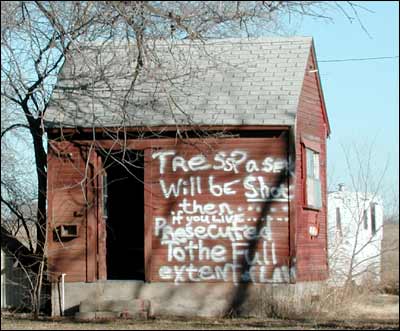
We all fear something. [December 26] I've lived in Dallas. I've driven in Denver and Atlanta. I've walked backward away from grizzly bears and clung to a cliff without dying, and I make deadline every night at work. I can handle anything. But some smaller things remain bugaboos for a very long time -- much longer than I expect them too. In January 2005, a year before I created PawneeRock.org, I was in Pawnee Rock and Great Bend while Dad got some medical things sorted out. I had free time, so I spent part of several days walking up and down the streets of Pawnee Rock, taking photos of every bit of streetside scenery as the remnants of a snowstorm melted into the ground. It was easy to start my project around Dad and Betty's house on Santa Fe. I had grown up on that street. It didn't take long, however, before I realized that the neighborhoods that used to give me the shivers still did. Making matters worse, most of the houses were filled with new people, strangers who might look unkindly on a prodigal son come home. Seeing Pawnee Rock through a viewfinder was the way I grew up, but I realized that nowadays I might appear to be a cop or a tax man. There was the western end of Bismark Avenue, where trees (even in winter) seem to close over the dead end and the houses huddle beside thick trunks; all I needed was Randy Wilson to step out and humiliate me. There was the north end of Barton Street, between the old Schultz and Dirks places and where a plane once crashed into a tree and burned; a ghost is there. And then there was the other end of Barton, a dead end south of the tracks where I had played in overgrown weeds as a grade-schooler. I'm sure the folks and dogs who live there now are pleasant -- I met a couple of the dogs -- but I kept expecting a door to open and let out a Stephen King character. I needed to overcome the suspicion that some guy with bad beard was going to point a rifle at me for capturing the soul of his house. There's nothing wrong with those places. It was just me remembering thirty-year-old fears. In fact, in five days of photography I was approached only four times. Randy Staggs, then the manager of Farmers Grain, pulled his pickup up beside me as I worked my way past his elevators. Bob Manka met me in the street outside his place on Houck and casually asked, "So, what are we doing today?" On South Rock, a woman poked her head out of a trailer and asked basically the same question. I told her that I was Elgie's son, and that right there seemed to explain or excuse everything. I added that I was taking photos so I'd have a record to pass along to my sons. The fourth instance, however, suggested that I wasn't the only one who had demons. As I walked up the eastern county road south of the tracks, a young man I hadn't seen yelled from his house, "I hope you got what you wanted!" and a moment later slammed his pickup door and drove off the property not down the driveway but through a muddy field. So, actually, I might have been right to have my qualms. But I did cover every street and reacquaint myself with parts of town I hadn't been in for years, and I'm glad I did. Those photos make a nice trophy. If nothing else, it proves that I conquered a vague fear. Walking the streets as a grownup helped me realize that my personal map of Pawnee Rock didn't have to be colored by my growing-up emotions. So that was settled. I made another discovery, however, that was unsettling. In exploring Pawnee Rock, I found a new town living in the houses of the old town. Despite my long ties to our hometown, I was the stranger. Keeping parents in the dark[December 26] The boys went to bed late on Christmas Eve with visions of sugarplums and NASCAR toys dancing in their heads. Sam woke up at 2 a.m. -- by some bit of fortune just missing Santa -- and was ordered back to bed by my wife. Nik came in later and woke my wife up, saying it was 7:30. She told him to wake me and we groggily gathered around the Christmas bounty. I happened to look at my watch, and it was 3:30. Outdoors was dark, but it was going to be dark until 9 and we never would have known the difference had it not been for the telltale timepiece. The boys, 11 and 9, had conspired among themselves to let us sleep an hour longer and then trick us into getting up. They even set their alarm clocks ahead so they'd have an alibi. Would such a thing have worked when I was a kid in Pawnee Rock? I doubt it. Dad had been getting up with the chickens, neither earlier nor later, since he was a toddler; his wake-up time was in his genes. Mom also was an early riser, and she was smart enough to check the clock or look out the window. Now, I know it's bad parenting to let the boys get away with such an escapade. But how were we to force the cat back in the bag, or the presents back in Santa's bag? I was proud of them for putting together such a ruse in the middle of the night. They were so happy, and in twenty years they'll tell their own kids about the night they tricked Mom and Dad. Be the happy Scrooge[December 25] Merry Christmas, everyone! I expect you all got very nice gifts, without a willow switch or chunk of anthracite in anyone's stocking. I haven't checked mine yet, and I'm hoping I get better than I deserve. Many of you e-mailed Christmas and New Year's wishes, and it brightened my snowy Monday and white Christmas. A few days ago, I wrote of Dickens' "A Christmas Carol." I don't know whether any of us had a visit last night from our personal Marley's Ghost and three spirits, but I would like to pass along Dickens' final Christmas morning statement about the enlightened Scrooge: "It was always said of him, that he knew how to keep Christmas well, if any man alive possessed the knowledge. May that be truly said of us, and all of us!" Thinking of past neighbors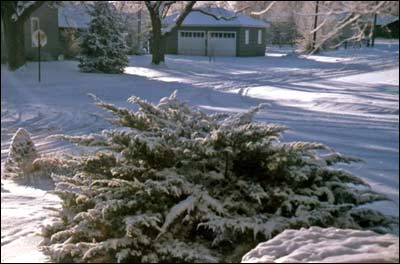
Earl Bowman's home, from across the intersection of Cunnife Avenue and Houck Street. Virgil Smith took this photo around 1970. [December 25] Virgil Smith of sunny Arizona sent a nice note and brace of photos to remind us of Pawnee Rock 35 years ago. Coincidentally, he and Joan lived two doors west of where Gary Trotnic, the snow-and-ice photographer, lives now. Here's what Virgil wrote: "Seeing the snow and ice pictures on your website reminded me of some winter pictures that I had. They were probably taken around 1970, judging from the vehicles that Willard Wilson had and there being no curbs. "The first picture [now in the Gallery] was taken looking north from our house towards Willard and Ruby Wilson's house. Willard still had the red Dodge Power Wagon, which was later replaced by a newer black one. Both were used to pull me out of a snow bank or the ditch on the mail route. How wonderful it would have been to have owned a cell phone then. I would walk to the nearest farm house and ask to use their phone to call Willard or A. B. Clawson, hoping that their dog would not attack me. I was lucky enough to be bitten only once. "Ruby [who died last year] worked at the school cafeteria and for a time as clerk at the post office. Sharol and Faye, their daughters, were good baby-sitters for our two oldest sons. Across the street to the north lived Ben and Josephine Unruh. Ben was the manager of Farmers Grain for quite some time. "The other picture [above] is looking southeast towards Earl Bowman's. After Earl died, Dick, their son, lived with his mother. He had the neatest hard-top, convertible Ford Thunderbird that he kept in this garage. He and Wayne Houdyshell, who lived next door with his mother, Lucy, would spend as much time as possible fishing. "At first, they went to a lake near Hot Springs, AR, and then, when Table Rock Lake in Missouri became productive, that was their destination. I used to think that they had a care-free life, but reflecting on it, I know that they were depended upon by their mothers. "When not fishing, Dick carved ducks out of wood. When we admired them and tried to buy one, he gave us two and refused any money. "The snow at this time was one of those rare ones that covered the ground and didn't blow. It was pretty to see, but we don't miss the cold." "Virgil" Stille Nacht, heilige Nacht[December 24] By the time evening fell and we picked up Grandma on our way to the Mennonite Church's Christmas Eve service, the wind would have gone still and the sky would be clear all the way up to the heavens. From my back seat on the left, I'd look out my car window and wonder which of those stars belonged to Baby Jesus. That singular star, of course, was the symbol of Christmas Eve services the world 'round, and ours in Pawnee Rock was no different. Christmas Eve service wasn't attended by everyone in the Bergthal Mennonite congregation; it strikes me now as being mostly for families with grandparents and parents who grew up in the church. No one threw the seating chart out, but families like ours that usually sat off to the side instead sat with Grandma on the middle pew where she had parked herself for decades. Our service started out solemnly with prayers, scripture readings, and songs like "O Little Town of Bethlehem" and "Silent Night," with a verse in German, the way our ancestors sang everything: Stille Nacht, heilige Nacht, And then there came the reading of the nativity story from Luke, and the mood of the service changed from solemn expectation to joy. "Hark the Herald Angels Sing" and "Joy to the World" trumpeted out of the organ, if you will, and we sang with spirit if not harmony. I don't think I was the only kid whose idea of joy came from the sure and certain knowledge that a pile of presents was that much closer to being opened. The service had reached its turning point, and we were heading for the sunny side of Christmas. As we filed out of the sanctuary, the ushers handed the kids brown lunch sacks of candy, nuts, and an apple or orange. Think about this: How traditional was the church to know that its kids would have a nutcracker at home and be willing to crack -- and eat -- a handful of walnuts, filberts, and almonds? Unlike most church events, Christmas Eve was something even the youngest of us could understand. It was a spirit we could share with anyone in the church -- even really old people we didn't know but who knew us -- simply by smiling and saying, "Merry Christmas." And say it we did as we gathered up Grandma in her cloth coat and walked out into the brisk night. As we waited for the Chevy to warm up, I pressed my cheek against the window and looked into the sky. On this holy night, which star belonged to Jesus? PIPM and Pawnee Rock[December 23] Brad Tew mailed a copy of "PIPM Ultimatum" to show me the role he imagined for a town named Pawnee Rock during a difficult period when the world gets too crowded.
Brad's Pawnee Rock appears as a pleasant island in a sea of change. Here are some excerpts from the first chapter: "Pawnee Rock even had its original Main Street, complete with clock tower and central park. There was an imposing white gazebo for special events, outdoor lectures, and marching bands. ... Wal-mart hadn't yet replaced the mom and pop country stores, and there were no cookie-cutter housing tracts or large-scale commercial developments. There were lots of dirt roads, small lakes and streams with plenty of good fishing, and wide open fields with corn, wheat and alfalfa. ... "Due to their uncommon stability, the townspeople managed to avoid most of the latest in technology: new and facier cell phones, more sophisticated computer games for the kids, and a larger assortment of worthless TV channels. ... "Pawnee Rock was a piece of Americana that time forgot. Most of the vistas were worthy of postcards. The residents were content and loved their piece of heaven on Earth. It was the only way of life they knew and they figured the rest of the world was pretty much the same."
Amazingly, this goes on without a worldwide revolt. In fact, the sheriff and his deputy hardly seem worked up about the loss of folks in their county; the disappearances cause more conversation than action. The PIPM plan, guided by long-winded, hard-fighting, hard-loving military leaders, goes beyond genocide and holocaust. In essence, the plan seems to be "how could we get rid of everybody who's not like us?" and it disconcerted me to see how easily the gung-ho protagonist dragged me toward that goal. I was fascinated by the mechanics of the plan despite my revulsion at the plan itself. I might quibble that the book practically ignores issues that I suppose would still be relevant in 2035 -- climate change, omnipresent electronic media, and so forth. The physical and behavioral world of "PIPM Ultimatum" carries a sense not so much of 2035 but of 2010. Being a Pawnee Rock native, I read with an eye toward how Pawnee Rock appeared and I was disappointed that the Pawnee Rock and countryside we know didn't show up. But as Brad wrote earlier, "Pawnee Rock" is a good name, and it's his story, not mine. I'm glad he chose "Pawnee Rock" to identify the town whose people learned to go along to survive. Once I started reading "PIPM Ultimatum," I had to keep going. It's a scary story and one that's easy to believe is possible. Brad is offering the 294-page paperback to PawneeRock.org readers at a discount: $18.50. Write to him (and send a check) to: PIPM Ultimatum order A photo I like: No. 66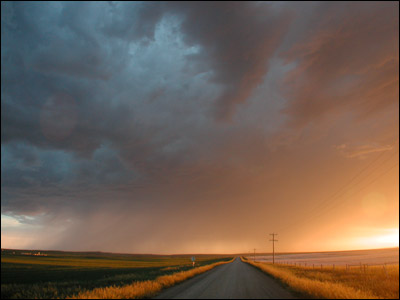
[December 22] I took this photo quite a bit north of Pawnee Rock. It was late in the day and the passing shower was illuminated nicely by the gentle sun. Twenty minutes after this, the sky's mood changed and the clouds threw lightning daggers at the ground and all men who stood on it. Once in a while I like a photo just because it's pretty. Happy winter! Now there's nothing to do but open presents, eat well, watch basketball and maybe shovel a little snow. And before you know it, it'll be Kansas Day, then Valentine's Day, and suddenly spring. About those Knights of Pythias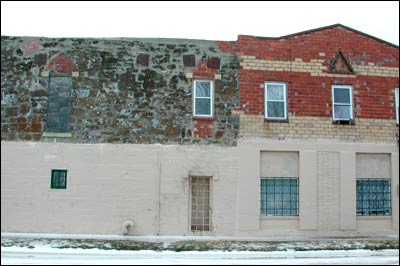
The Knights of Pythias met in the top floor of the old opera house. The lodge's triangular logo was built into the brickwork. [December 21] The Knights of Pythias, which had its local chapter in the old opera house in Pawnee Rock, was more than a club where men could dress up in capes and feathered hats. It was founded in 1864 in Washington, D.C., and has a couple of thousand chapters in the United States and Canada, according to the organization's website. 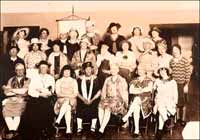 My dad once showed me some of the robes the Pythians wore, and we've had a couple of photos of the lodge and its members here on PawneeRock.org. (The one that comes to mind first is of the members dressed up as women.) They met upstairs at the opera house, when it was a cafe. Leon Miller, a Pawnee Rocker in Dallas, wrote yesterday to mention that the Knights of Pythias "is primarily an African American fraternity in the south." That, of course, is the polar opposite of the membership of the local chapter when it existed in Pawnee Rock. I did a little looking around on the web and found the Knights of Pythias website and an entry on Wikipedia. Here's part of the Wikipedia entry: "The Knights of Pythias was the first fraternal organization to receive a charter under an act of the United States Congress (approved May 5, 1870 [16 Stat. at L. 98, chap. 80]). It was founded by Justus H. Rathbone, who had been inspired by a play by the Irish poet John Banim about the legend of Damon and Pythias. This legend illustrates the ideals of loyalty, honor and friendship that are central to the order. "The order's membership was originally restricted to white males. In 1880, an organization called "The Supreme Lodge Knights of Pythias, North and South America, Europe, Asia, and Africa" was founded; it reserved its membership to Blacks and Asians. The original order sued, alleging that the new order used the name without authorization. The case reached the U.S. Supreme Court which ruled that the new order was allowed to use the name. "The racial requirement for membership was dropped in the 1950s. Although belief in a Supreme Being is a major element of the Pythian creed, the organization is completely non-sectarian and has never restricted membership on the basis of religion so long as one follows this belief in some form or other." Some famous Knights (Pythians?) were William Jennings Bryan, Warren Harding, William McKinley, Hubert Humphrey, Nelson Rockefeller, and Franklin Roosevelt. Frozen turkey: On December 14, I posted a few tidbits from the Pawnee Rock Community News of December 1995. One of the items was a list of the folks who won turkeys, hams, and sausages at the Lions Club drawing, and one of the winners was my brother-in-law, Dave Leiker. My dad had bought the ticket for him; he and my sister, Cheryl, live in Emporia. They drove the 150 miles to collect their turkey. Cheryl wrote: "When Dave and I went to PR to claim the turkey, we had to go to the gas station and pick it up from Howard -- it was in his freezer there -- in amongst the ice cream bars." That informality is one of the things that makes Pawnee Rock a place to remember. Stay up for winter: Winter begins at 12:08 a.m. Central time Saturday. Every day after that for six months will get longer and longer, and I say it's about time. And in case you're wondering, the full moon will appear just before Christmas Eve. Let's hope it comes upon a midnight clear. Unrolling history[December 20] Larry and Carolyn Mix of St. John had a historical photo that was 36 inches wide by 9 inches tall. The trouble was that it had been rolled up for storage long ago and they couldn't get a good look at it without damaging it. "We've had it laying around trying to get it to lay flat. When we got the photo it was cracked on the left side and stained on the right side. It was rolled up about the size of a Pringles Chip can and about as hard," Larry wrote. "We were told to put it around a round object and let it sit in the open as that would allow it to uncurl without any more cracking. "Well, it worked. We just got it framed and thought we would send you some photos we took of it." I pieced it together -- the Mixes did a good job of making each of the four images the same depth, which made it easy to match them up. I brightened them in Photoshop by increasing the darks and whites, which added contrast. The photo is on the homepage today, which doesn't really do it justice. So I put a larger version of it in the Big Pictures Gallery. To top it off, I put each of the four separate images into the regular Gallery, so you can look at them in even greater detail. You can find more about Larry and Carolyn on their definitive Santa Fe Trail Research Site. Let the sun shine: Yesterday, on my way to trying to impress sister Cheryl with the low angle of the winter sun where I live, I came across a website that has all kinds of good sunrise/sunset information. For example, it says that today in Wichita -- and all towns on Wichita's latitude, which is pretty close to Pawnee Rock's -- the sun will be up today for 9 hours, 33 minutes, 13 seconds. And when it is the most "up," at its peak at 12:27 p.m. in Wichita, the sun will be 28.9 degrees above the horizon. If you're a stickler for detail, the sun will be 147,165,000,000 kilometers away. Tomorrow you'll be 11,000,000 kilometers closer than you are today, so put on extra sunscreen. You should consider yourself fortunate to be in such balmy conditions. Where I live, we'll have 5 hours, 27 minutes of sunlight today. The sun will peak at 5.5 degrees above the horizon, which is barely a peek at all. The ghost of a Christmas present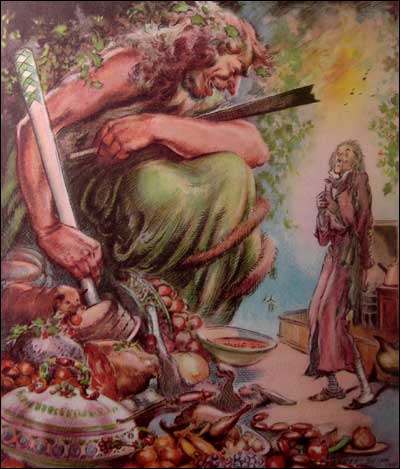
The Ghost of Christmas Present visits Scrooge. Three illustrations by Everett Shinn. [December 19] Last weekend, while our family was decorating the Christmas tree, I pulled down from a high shelf my copy of Charles Dickens' "A Christmas Carol." Nik, who was on the couch with me, had never seen such a book. 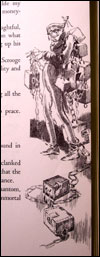 It is the book I've had the longest. My Uncle Don and Aunt Norma gave it to me when I was almost two years old. I started reading "A Christmas Carol" when I was nine or ten, about Nik's age. I didn't understand it all as a youngster, but I got the plot and the rest soaked in over the years. Everett Shinn's drawings -- extravagant and plentiful and piercing -- became my images of England and Christmas and Plenty, as well as Death. My Grandpa Unruh had died in his farmhouse bed about that time, and I was having nightmares. "A Christmas Carol" made some of them worse, because obviously death with its ragpickers and ghosts could be a very unhappy experience. Even a fourth-grader knows he is one step away from the lake of fire -- our church made sure we knew that -- and the Spirits could slide into my room in the night. Any night, just like they had for Grandpa. As I curled up in my bedroom and worked my way through the book, December after December, it became a more personal guide than any other book I had. The Bible was about love and everlasting life, but Scrooge and Cratchit, Fezziwig and the remorseful Marley were characters I could identify with, and there was redemption at the end. 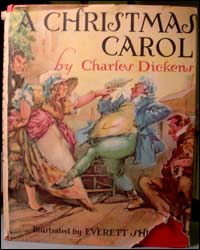 I don't know whether I ever told my sister or parents, or Don and Norma, how I loved "A Christmas Carol." The book has been a secret I've held to myself, because speaking it cannot adequately express the layers of meaning and emotion. In a different way, the book itself was a matter of faith. My mom's brother and sister gave me a masterpiece that was far beyond my understanding, to be put away on a high shelf until I was ready. They had faith that I would read. Now it's time for me to pass "A Christmas Carol" to the next generation. I'll move it to a lower shelf, and it'll be there when Nik's ready. Legends from when life was hard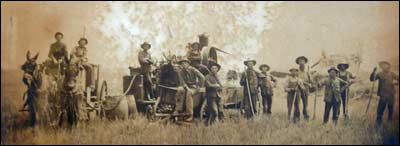
Threshing crew from the early decades of the 20th century, when cutting wheat was hard, hot work. [December 18] When we were kids at midcentury, we all heard about how our parents walked three miles through hip-deep snow to a one-room school. Across the pastures. With only a baked potato to keep them warm. Against the wind. How much of that was true, and whether it was true more than once or twice, I can't say. It really doesn't matter, because legends like that are what make our ancestors' lives so interesting. If we start pooh-poohing those stories, our own Tales From Childhood might be the next to fall by the wayside. And that's a real risk, because our tales are not nearly as imaginative as our parents'. But before we start feeling like 98-pound weaklings in the memory department, we have to realize that what we did filled our lives as much as our parents' adventures filled theirs. Between our parents' childhood and ours, the Depression and a couple of wars had come and gone; space, not rural Kansas, was the next frontier. So, all you folks in your forties and fifties, pull up a kid and reveal what the world was like before iPods and SUVs. Tell how we used to ride our bikes all over Pawnee Rock and play baseball on vacant lots, because there were enough kids in town to do that. Or how we lined up to play Pong, the first video game, down at Bob's Place, which sat across the highway from the depot. Or how we had to talk to the operator to make a phone call to Larned. Or how we read newspapers and Life magazine instead of websites. Or how only new cars had seatbelts and people could get free maps at gas stations, where gas was 37 cents a gallon and beer was legal for high school seniors to buy. How we always cooked our food in a pot or a oven and not in a microwave oven. Or how we happily got our entertainment on two or three black-and-white TV channels and our music on AM radio stations from Larned, Great Bend, Hays, Wichita, and KSAL of Salina broadcasting from Cloud County, Kansas. And how the movie theaters were real theaters in the county seats, and the county seats also had drive-in theaters that showed 50-foot-high half-naked people to the whole world. Or how there was enough water in the river in the summer to get our knees wet. And how there were fish in Ash Creek. And how we bucked bales onto a trailer for a nickel apiece and took Cessna rides for a penny a pound. Sure, the kids today already have heard that we paid 37 cents for gas, but they're not going to believe that yarn any more than our silly tales about nickel candy bars and penny jawbreakers. No, our adventures aren't as good as our parents' were, but they're the best our generation could do in an increasingly civilized Kansas. Imagine the stories that our parents were told by their parents. I don't think I want a life hard enough to be talked about for generations to come. I'm glad my parents' generation is the last one that has good stories about accidentally burning down the outhouse; I don't miss outhouses. If the folks born in the 1920s and '30s want to go on about how they had to crank the tractor while juggling a bucket of milk and a pitchfork barefoot, I'm going to believe them. Who am I to doubt a living legend? Still, there's hope for us soon-to-be fogies. As long as we make our children's lives easier than the ones we've led, our adventures will be exciting by comparison. And then the kids will be able to glance at each other with the look that says, "Oh, that's why Dad's so weird." E-mail: There was a little e-mail problem yesterday; maybe your service was sticky too. If you sent me any e-mail Monday afternoon that I didn't acknowledge, please send it again. Secrets taken to the grave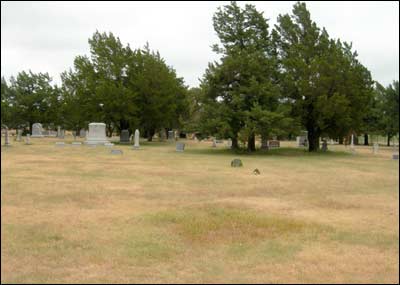
[December 17] Section 4 of the Pawnee Rock Township Cemetery is mostly vacant -- above ground, at least. There are a couple of markers, carved a century or more ago from the Dakota sandstone that underlies the area and pops into visibility on farms and in the bluff that makes up Pawnee Rock State Park. 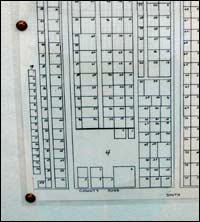 Someone chose two pieces of this rock to mark graves in this wide-open area. The names and dates, if there were any, eroded long ago, but the stones clearly were handworked into gravestone shapes. Each spring, when I was younger, two tulips pushed up through the chill and bloomed within inches of the larger stone. Someone planted the tulips; someone loved whoever is buried below. I don't know why the empty area isn't marked with plots on the cemetery plat, although my dad, when he was sexton three decades ago, suggested that the folks buried there were paupers and had no one to buy stones for them or that the dead there had died of an epidemic and lay in a mass grave. Or perhaps the first users of the cemetery were laid to rest before anyone started keeping records of who went where, or maybe they were not whites. Whoever sleeps there does have neighbors besides grasshoppers and ground squirrels. Surrounding the open area are family plots for old Pawnee Rock families: Dirkses, Gilberts, Mosbergers, Morrises, Sieberts, Spreiers, and Williamses. 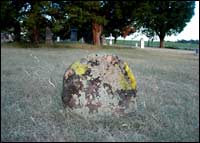 The little sandstone markers always got my special attention when I was clipping around headstones before Memorial Day and later in the summer. Down on my knees, I pulled the unmowed grass away from the rock and scissored it off close to the ground. Unlike the granite and marble stones, these could be damaged by a scraping blade so I was careful. It was peaceful there in the "pasture," as I thought of it. Just the two stones, tired from years of telling what they knew and now saying only that "here lies a human." The names of the departed and of the grieving may be lost to eternity. But perhaps somewhere there's a family that still remembers, that still thinks of the graves when tulips bloom. Storms make for a long week[December 16] Last week wasn't very pleasant in Pawnee Rock. The power was out from Monday night until 9:15 a.m. Friday, writes Gary Trotnic. On top of the damage left by the ice storm Monday and Tuesday, the city got about 10 inches of snow Friday and Saturday. "Limbs are down everywhere," Gary wrote. "My Internet is off and on." Gary wrote that he and Aleta stayed in their home until it got down to 49 degrees inside and then they went to Larned for a couple of nights. Leona Niedens of Pawnee County[December 16] You may have noticed that Leona Niedens died Thursday in Larned. She had lived there since 1945, her obituary in the Hutch News said. 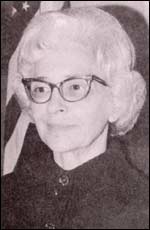 If you had a relative's will probated in the 1960s, 1970s, or 1980s in Pawnee County, there's a good chance Leona was the judge or clerk in charge of the matter. In fact, it is because of her judgeship that I really know anything about her. In the mid-1970s, when I worked for the Larned Tiller and Toiler, the county's official newspaper, it was the responsibility of one of the reporters -- in this case, Bruce Janssen, who grew up in Holyrood -- to collect the list of cases that were probated. After several months of doing so, Bruce decided that he could manage the probate office better than Leona had, and so he ran for the job. (I took a photo of him and his wife and daughter in his garden for use on his campaign cards.) He won that race and held the job for, I think, four years while Leona sold goods in a store downtown. Being a summer intern for the paper and at KU the rest of the time, I wasn't privy to how well Leona handled her rejection by the voters. But when the next election came and Bruce gave the job back to the county, Leona stood for it and was re-elected. Leona struck me as the essence of "old Larned," with connections going back to the end of World War II. I respect her for not giving up, and I suppose that her resilience -- and Larned's return to the way things were before -- says a lot about both Leona and Pawnee County. Leona Niedens' funeral will be at 10 a.m. Monday at Grace Lutheran Church in Larned, and she will be buried in the Larned Cemetery. She was 89 years old. Snow depth: If you're curious about how much snow is on the ground near Pawnee Rock, check out this compilation of observer reports from across Kansas. A photo I like: No. 65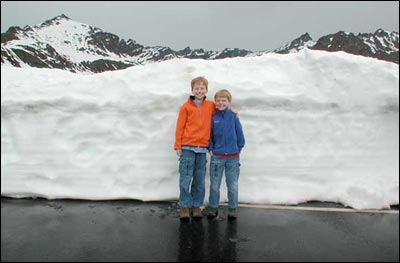
[December 15] I like living where things are bigger than life. In Kansas, that's the sky and the wind. In Texas, everything's bigger than life. In Alaska, it's the snow and mountains. I took this photo of our sons on Memorial Day weekend not far from where we live. This is the snow I dreamed of as a kid reading adventure stories set in the north woods. In our wilderness -- the dusty Arkansas River drainage where I posed for childhood photos -- we never had anything like this, of course, but in my mind I walked out of a cabin many times to check my mink trapline, leaving a long trail of snowshoe tracks. And perhaps I watched too many Disney movies about bears waking up to tinkly music as the snow melted in the spring. That's why I posed our sons in front of snow. In 40 years, they'll remember snow the way you and I remember loam. About the Legion and a flood[December 14] Leon Miller and Don Ross wrote about photos we've had on the homepage this week. Yesterday, the photo was of the American Legion hall in the old fire station before it was moved to the south end of town. The post met there until the 1980s, I think, when it moved into the former grocery store downtown. The post is now closed.
Normally, I think of floods as coming down the ditches from Ash Creek or the Arkansas River, but in the 1950s, it came from the north. Leon Miller: "My dad, Cobb Miller was one of the most devoted members of the Albert O. Tacker post of the American Legion. In fact, I believe he spent most of his free time at the Legion Hall, which was across the street from where I grew up.
"I couldn't swear to it but I think the person at the lower left of the photo is Cobb. The reason I say that is this person is wearing a hat similar to what my dad wore and the way it is cocked on his head makes me further believe that its him. "Also, I think the man on the right facing the camera as Bill Schroeder. The old grizzly fellow kinda reminds me of Raul Fry." My dad, who provided the photo, told me that the man in the hat and tie in the background is Otis Unruh, my grandpa. He thinks the man in the overalls on the left, turned away from the camera, may be Stanley Tutak. Don Ross: "You know we had a bad flood in PR, I think it was in the '50s sometime. It was the same time that Little Dave Schmidt was killed by a tornado that took his house. His wife Eva, everyone called them Little Dave and Little Eva, she went to the cave but he stayed in the house. [They lived on the first road north of where Earl and Janice live and a half mile west, so about three miles north and two miles west of town.] "Anyway it was before they built the dam up by the salt mine and the heavy rain flooded the city. Every basement in town was flooded. Halliburton, Dowell, Pawnee County and others came to town and pumped out the basements at no charge. I remember wading up to my mom's house and she said look into the basement to see if any water got in. Water was up the ceiling light bulb. "Earl Allen Schmidt and I were the first ones to arrive at Little Dave's place. He was laying on the ground in the yard. I saw some movement but Earl said he was dead. This was a bad storm." In the news, December 1995
[December 13] There was plenty of news this week 12 years ago. The 20th Century Club and the Half Century EHU met, and there was the annual drawing for turkeys and sausages. The following snippets were recorded in the Pawnee Rock Community News of January 12, 1995. That was edition No. 123 of the monthly bulletin published by the Pawnee Rock Ministerial Alliance. At the time, the News was prepared by the Beachys. My favorite part of reading these is seeing the names of old acquaintances and friends. Let's hear it for club secretaries! Club newsThe 20th Century Club met at Becky Peak's home South of Great Bend Dec. 15 at 6:00 p.m. Berdene Russell was co-hostess and she and the hostess served tea and hot apple cider with the finger foods brought by the members. We enjoyed the hour visiting and then all went ot Fantasy Village which was just two miles North. In spite of the cold winds which made it seem more like Christmas the tour was an inspiration and enjoyed by all. The next meeting will be with June McConnaughhay in Larned Jan. 19. The Half Century EHU met on Dec. 13 at the Petroleum Club in Great Bend for a Christmas luncheon and gift exchage with 11 members present. The next meeting has been changed to be held at the home of Pauline Smith Jan. 24 at 1:30 p.m. Lions Club DrawingWinners of the drawing held Sat., Dec. 17, sponsored by the Pawnee Rock Lions Club were as follows: Winners of turkeys were Bob Girard, Brian Harrison, Bill Robbins, Wilbur Russell, Carol Edwardson, Kim Bandy, Dorothy Bowman, Don Lee, Jack Link, Gary Rainbolt, Arthur Sayler, J. Staggs, Tag Henricks, Doyle Foster, Florence Johnson, LeAnna Unruh, Gene Schmidt, Richard Mead, Karen Clark, Dan Stafford, Dave Leiker, Melinda Adams, Bob Kuskie, and Chandra Walls. Those who won roasts were Brandon Ritchie, Tricia Walker, Bill Linderer, Randy Staggs, Joshua Schmidt, and Doug Smith. Those who won sausages were Dixie Haberman, Gwen French and Jim Unruh. Our thanks to those who donated funds for the event. They included Farmers Grain and Fuel, Mull Farms, M&M Upholstery, Vown Epperson, Roth Equipment, First State Bank, and Farmers Bank and Trust and Beckwith Mortuary. FoundA pair of prescription glasses. Call 982-44xx if you've lost them. Robert Delaplane of Sweden[December 12] Robert Delaplane wrote from Sweden to identify three people in the Schultz nieces and nephews picture on Gallery page 41. One is his mother, Gladys (confirming Larry Smith's notion), as well as Roy Smith and Galen Koehn. Robert wrote that his family lived in Pawnee Rock from 1950 to 1979. He graduated from Pawnee Rock High School in 1960. Figuring out what happened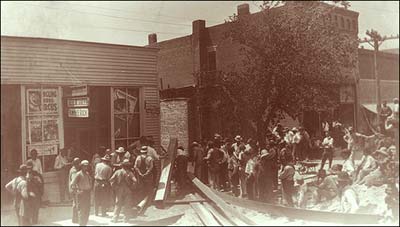
[December 12] When Don Ross sent the image of the crew working on some project in old downtown Pawnee Rock, I was pretty happy. One doesn't see many photos of construction projects, especially a shot decorated with circus posters. I knew, though, that I had a shot taken about the same time; it's found on page 17 of the Gallery. What surprised me was how closely related the shots were; it looks as if they were taken on consecutive days. Don did such a careful job of printing the old negative that he brought the image to life. His photo reveals what kind of posters those are and gives us a look at the street before it's awash with pumped water. I had assumed, from looking at my photo, that the street was muddy right after a rain, but in Don's photos a bunch of people are sitting on a pile of excavated dirt, which they wouldn't do if it were muddy. It could be that it rained on the day the second photo was made. All this assumes that I've got the photos in the right order. It seems likely that people would gather to watch water be pumped out of someplace it shouldn't be, certainly. What makes me positive that Don's photo was taken first is that I can't imagine the gentlemen of downtown gathering to watch a disaster operation be taken apart, but they would gather to help supervise its construction. All the hubbub makes me wonder whether there wasn't something else going on that we don't know about -- did a basement wall collapse, or did someone fall in and drown? Don's photo shows, on the right, that the powerlines are hanging loosely to the street, also a detail we hadn't had before. Discoveries like this, while small and arcane, make studying our hometown's history fun. Maybe it's not as much fun as watching a basement be pumped out, but it's still fun. It's good for the wheat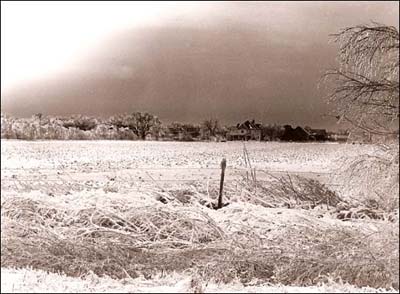
[December 11] Our stockings soon will be hung by the chimney with care, and on the Christmas tree we'll hang plastic icicles or tinsel. Maybe the tree will be flocked with pretend snow. We'll talk fondly of childhood snowball fights and, if we have to, we'll watch Frosty the Snowman on television with the kids. We'll read The Night Before Christmas and be enchanted by the mention of newfallen snow. When it snows or gets icy, as it did Monday in central Kansas, we of dryland ancestry might even turn to our spouse and say, "It's good for the wheat." But is snowfall something we like more in memory than in life? Kids love snow. Heavy snow or ice may cancel school, although the thrill may be not in missing school but in simply doing something out of the routine. Kids need snow every winter so they'll know what snow angels are and how it feels to get a snowball down the back of their coats. They need to ride a sled down the Rock and push a snowshovel down the sidewalk, and how else are they going to learn to break an icicle off cleanly and lick it like a lollipop? For us grownups, snow and ice can be inconvenient. We don't like things that make driving more difficult. We don't like falling down in public. We don't like it when the power goes out and we realize that we're not prepared to go a single day without the grocery store or the 7-Eleven or Blockbuster. We don't like it when our Internet and cable don't work, and we especially don't like it when the cold furnace can't protect our pipes. We don't like the stress of missing work. We don't like our routine broken. You and I may hate to admit it, but most of the time we want nature to keep its distance. Still, nature prevails. If nature wants give us a winter wonderland, we're going to get decorated. And in a few years, Pawnee Rockers will talk fondly of how they survived the Ice Storm of Aught Seven. I know I should have outgrown it, but I still feel like a kid when we have a big snow in the picture postcard setting where we live now. I enjoy shoveling the driveway; the deeper it is the more there is to brag about. The boys ride their sleds, and we're generally prepared for when the power goes out. Snow is the routine here. Once in a while, our sons will ask why I stand at the window and watch the flakes pile up. I've tried to tell them of a little boy in red boots and sodden cotton gloves building a snowman in his front yard, but in their own childhood a snowman is a common creature and they're not impressed. So I just turn and say sagely, "All that snow, it's good for the wheat." James Flick and the Rock Hotel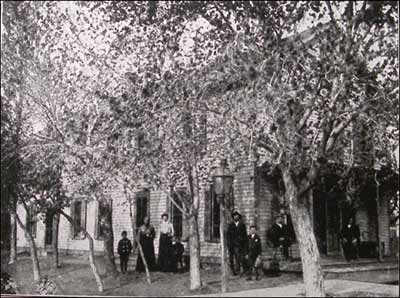
This photo of the Rock Hotel probably was taken in 1911 or 1912. It appeared in the "Biographical History of Barton County, Kansas." [December 10] Maybe some of us are old enough to remember the Rock Hotel, standing on the northeast corner of Centre Street's intersection with the highway. For me, however, the Rock Hotel is a mythical place known only through black and white photographs. I wish I had known the town in the early days, when Pawnee Rock was important enough to have a two-story hotel right across from the depot. In fact, the hotel was one of the town's first buildings. One of the hotel's early owners -- I don't don't whether he was the hotel's founder -- was James H. Flick. I know one of his descedents, Tom, lived on Centre at Santa Fe Avenue, but I'd really like to know where James lived when he moved to town from his farm. 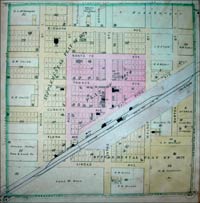 As the biography below says, he did own considerable property in town. For example, the 1902 Pawnee Rock city plat shows the Rock Hotel as well as a block Flick owned north of Santa Fe between Walnut and Barton streets (many of us later would know it as the block anchored by the Carpenter, Ritchie, and Bowman homes, east of the New Jerusalem Church). Here is his story through 1912, taken from the "Biographical History of Barton County, Kansas." James H. Flick"Of the men who have taken an active part in the upbuilding of Pawnee Rock and the development of Barton County none is better known than the subject of this sketch, James H. Flick. "Mr. Flick was born October 10, 1851, in Lycoming County, Pa. When he was thirteen years old the family moved to Illinois where James remained for twenty years. He came from there to Barton County in 1887. He took up a homestead and bought land near Pawnee Rock and at once took a part in the development of the county's resources. "His old home is now known as the Fish place, he having disposed of all his farming interests several years ago when he moved to Pawnee Rock and went into the hotel business, and it is safe to say that there is no hotel in the state that is better known than the Rock Hotel of Pawnee Rock. He still owns the hotel building but gave up the operating of it six years ago. "In addition to the hotel Mr. Flick owns a nice residence and considerable other town property. He was married in Illinois to Miss Sarah Keith. They had two children, Daniel and Florence, the latter of whom is dead. Mr. Flick survived his first wife and in 1884 was married to Miss Sarah David and to this union there were born seven children all of whom are deceased except Jessie who is now living in Pawnee Rock. "Mr. Flick has always been one of the leading citizens of Pawnee Rock and has had a great deal to do with its upbuilding and making it one of the important towns of the county. He enjoys a wide acquaintance in all parts of the state of Kansas and is well known among the traveling fraternity. "He is one of the really old timers who saw this county when it was struggling with the hard times and has seen it grow to its present high standing in the State of Kansas." 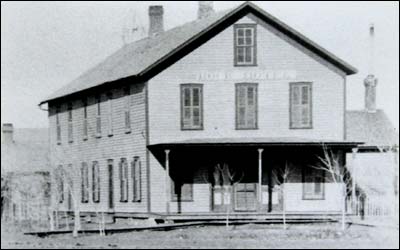
This is a detail of a photo made of Pawnee Rock in the late 1880s, looking north from the intersection of Centre Street and the highway. It may be the earliest existing photo of the Rock Hotel. 
This photo shows downtown Pawnee Rock in the early 1910s. The Rock Hotel, with an adjoining room that may be a kitchen, is at the left margin, next to the Gano office. 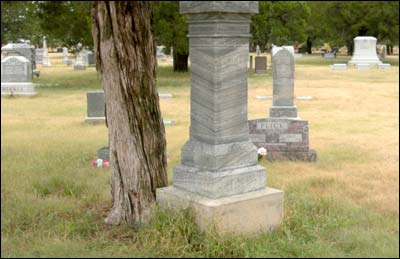
The earliest Flicks in Pawnee Rock are buried in the western half of the southern center section in the township cemetery. The cattle auction[December 9] Virgil Smith, as you'll remember, grew up on a farm northwest of Pawnee Rock. Here are some of his thoughts: As a young farm boy, an exciting time for me was being able to go to the cattle auction in Larned with my dad. The Doll Livestock Commission was an important site for farmers, cattlemen and meat suppliers to buy and sell their livestock and the sale often ran into the evening. Almost every farmer raised various kinds of livestock for their own needs and to earn money for the welfare of their families. There were bidders from different packing houses and wholesalers, buying cattle for meat to be supplied to area grocery stores and meat shops. Each one had his own subtle way of making a bid that was obvious only to those receiving the bids. Usually, there were two or three spotters watching for bids. There was a large auction arena with bleachers on three sides and on the fourth, was the auctioneer's stand with gates on either side for the livestock to enter and exit. The area for the livestock was a tall pipe enclosure. There were rows and rows of pens outside to hold them before and after they were sold. The older pens were built with wooden planks and the newer ones of pipe and concrete -- strong enough to hold the most enraged bull. When I was a teenager, I got to work there some of the time during the summer for the Thursday cattle sale along with other teenage boys from the area. It was my first job that required a social security number, for which I had to apply. We would drive the cattle from the pens to the sale ring. There were gates to open and close in front of and behind the cattle so that the cattle lots would be kept separate. We had cattle prods or whips. Mine was homemade but did the job. A lot of walking was required and one day I went to work with a new pair of jeans that hadn't been washed. By the end of the day, the inside of my legs were raw. When I was still pretty young, my dad let me bid on and buy a small Hereford calf. I was in awe of the fast-talking auctioneer and had to listen closely to know what the bid was. The calf was still young enough to need milk and I would feed it by putting my fingers in it's mouth and letting it suck on them and then pushing his muzzle in the milk in the bucket. After he learned to recognize the milk in the bucket, my fingers were no longer needed. I raised him until he was about 800 or 900 lbs. and we become quite attached. My mother would give me soda crackers for a snack and I would share them with him. When I went to get the cows in the pasture at milking time, he would come to me for his snack. I started to lay across his back and eventually climbed on to ride. He didn't seem to mind and a nudge in his ribs with my heels, would usually make him go. If not, a pull on his tail would. I had to be careful though, not to pull too hard or I might get bucked off. I hated to part with him when the time came, but as a farm boy, I knew that it was inevitable and looked forward to a new project. A photo I like: No. 64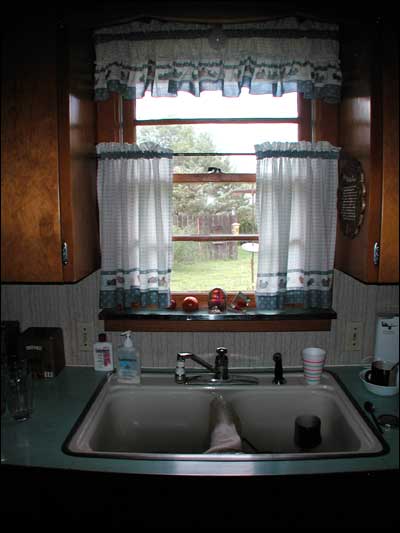
[December 8] Here's the kitchen sink of the home where I grew up. It's the focus of the house. Even though I made this photo in 2005, the sink and view are almost the same as when I officially moved out twenty-six years earlier. This photo relaxes me. George Brannan dies[December 7] George Brannan, it turns out, was a World War II pilot who grew up in Larned in addition to being the Great Bend man who took many of our school and wedding pictures. George died Monday at age 89. His survivors include a sister, Maxine Foster of Pawnee Rock. (Obituary) Homegrown postcards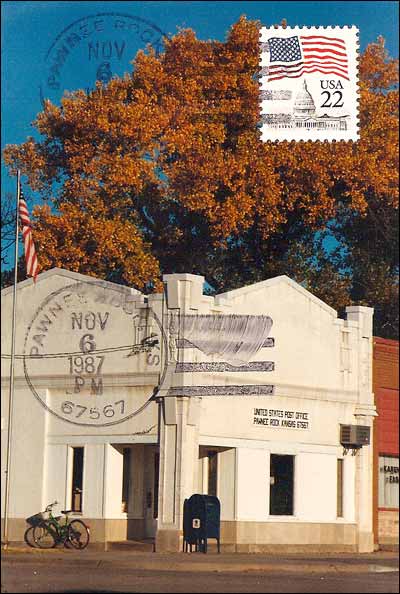
[December 7] Being a stamp collector and a rural letter carrier, Elgie Unruh was always testing the limits and humor of the Postal Service. Elgie (or Dad) bought all the stamps and first-day issues you'd expect a philatelist to acquire, but he didn't stop there. He mailed postcard-size pieces of wood. He dropped envelopes -- addressed only to Box 7, 67567 -- into boxes at distant post offices and waited for them to show up in the family box. Another of Dad's hobbies was going to every county and photographing every post office. I don't know whether he finally got them all before he settled into his quiet years, but I do know that somewhere he has boxes and boxes of post office prints. In 1987, Dad combined his passions by photographing the Pawnee Rock post office and postmarking the print, making it a postal postcard. By the same token, we know what Pawnee Rock State Park looked like in the autumn of 1987. Dad came up with a great way to record the way our town looked on a certain date. It reminds me of the postcards of houses that our grandparents used when they wanted to show their distant friends what Pawnee Rock looked like in the early 1900s. Dad was more adventurous than I. To me, struggling to learn photography 15 years before Dad took these shots, each of my prints was a treasure. I don't think I ever intentionally marred a print with a postal stamp or even a rubber stamp. I'm glad now that I kept all my pictures -- I think I have every one -- as clean as the day they were printed, but I do wish that sometimes I had been less earnest and more playful. 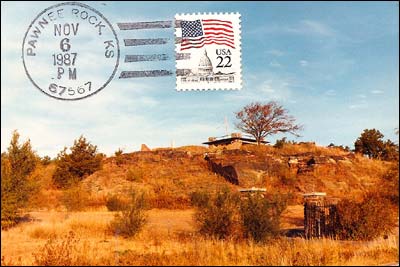
Pawnee Rock State Park, photographed by Elgie Unruh in 1987. Hanna's by the highway[December 6] Don Ross and Leon Miller remember the Hanna family cafe mentioned by Virgil and Joan Smith: Don wrote: "Hanna's cafe was in the building on the hwy where there is now an antique store. The sandstone building. Lloyd was the son." Leon wrote: "I, too remember the name Hanna. Lloyd Hanna would have been around the time of my sister, Corinne, who graduated from PRHS in 1943. He may have been a year or two younger. I think the Hannas ran the cafe and gas pumps at the now antique store, which was the old opera house." He also remembered his home's phone number. "Our phone number, until the 'new' numbers came out with the Yukon 2 prefix, was 11. Simply, 11." Pawnee Rock vs. Radium[December 6] I wasn't much of a football player in seventh grade. For all my intentions of becoming a wide receiver and catching long touchdown passes, I was turned into a guard -- coach Bernard Williams put my 95 pounds up against guys weighing 150 pounds or more in the middle of the line. Sure, it's a scenario in which the tough little guy shows how tough he was. But most of the time, it's a recipe for getting clobbered. 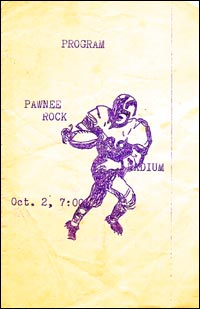 The only souvenir I have of that season is a mimeographed game program I discovered in a box of childhood souvenirs. On October 2, 1969, our Pawnee Rock Warriors played the Radium Panthers. By 1969, Radium -- 11 miles southeast of Pawnee Rock -- was little more than a few homes with a elevator and a joint post office and grocery store. But most of the families with kids lived on farms anyway. Radium suited up nine Panthers against our twenty-two Warriors for the game, which I think was played on the eight-man field behind Radium school. Both sides had cheerleaders; ours were Crystal Davidson, Anita Loving, TaWanna Mason, Brenda Schmidt, and Susan Schmidt. The game shouldn't have been close, and it wasn't. According to the score I found in my handwriting, Radium won 28-8. The athletic rivalry between Pawnee Rock and Radium went back decades -- baseball games are mentioned in the Pawnee Rock Heralds of the 1920s -- but it was near its end. Radium's junior high was in its last years, and the handwriting was on the wall for Pawnee Rock's too. Three autumns after this football game, our high school was closed and many of us Pawnee Rockers joined our former rivals at their district's high school in Macksville. It was fun to become friends and schoolmates with boys we had competed against in football, basketball, and track. We had our old games in common, and we bonded as survivors of towns that had lost their schools. Pawnee Rock by the numbers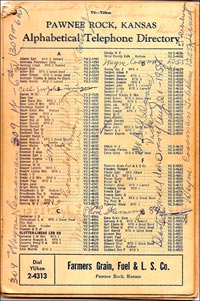
[December 5] I bet you remember the phone number your family had when you were a kid. Mine was 4684. Grandma Unruh's was 4458, and she was on a party line. The post office's was (and is) 4308. Of course, Pawnee Rock had a quaint prefix, YUkon 2, but we didn't have to dial it when we were calling around town. In a pile of stuff I got from Dad was a set of Lillian Sweeney's phone books from the 1950s. Reading the names is like driving the streets of town and township again, waving to the neighbors. One of these days I'll scan in a whole book and post each page. Here are some other numbers. Of these, only Farmers and City Hall are still in business and using the same number. City Hall, 4386 Fire, 4392 Federal Bureau of Investigation (F.B.I.) I was always amazed that I could call the FBI if I wanted to. What kind of crime would I have to witness to earn that call, I wondered. Were Communists lurking in Pawnee Rock? Also, until I saw this I didn't realize that when Mr. Tutak owned the drugstore it was called Stanley's Sundries. Downtown buildings: Joan and Virgil Smith put some thought into the nearly forgotten buildings of downtown Pawnee Rock. "Our recollections of the downtown buildings are pretty hazy," Virgil wrote. "There was a student named Lloyd Hanna. I think that his parents had a cafe in one of these buildings. Joan thinks that Virgil Gilbert had a furniture store at one time someplace here. These are our impressions. Sorry that we can't be more specific." Do those names and descriptions ring a bell with anyone else? The smile of a boy turning three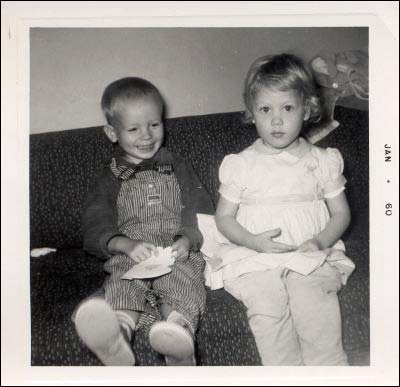
[December 4] This is me on my third birthday, in December 1959. I'm sitting on my couch with my good friend and constant companion, Ida Deckert. My folks, Anita and Elgie, and her folks, Helen and Adam, hung out together all the time, and as parents go so go their kids. Ida and I even had chickenpox together the following year. I'll point out for the sake of propriety that Ida is months younger than I. Back on this occasion, a day so chilly that Ida wore long pants under her dress, friends and family had gathered to honor me. A three-year-old is already the center of the universe, and public acclaim is icing on his lemon cake. For all that, this photo doesn't evoke birthday memories. What I like most about it, aside from Ida and my grin, is the couch. The upholstery was dark brown, and the light-colored flecks were created by a brittle gold thread. I had endless hours of fun driving my pre-Matchbox cars on that couch, bouncing across each gold-filled pothole in the fabric. The gold threads resisted my attempts to pick them out for closer inspection, but that's just as well because Mom had a hairbrush to gently guide me toward nondestructive behavior. (I didn't need a hairbrush on the top end until I was in fifth grade and grew hair long enough to push to one side.) The couch served as a sickbed, study hall, and perch for company. Eventually it was replaced by an off-white couch with padded cushions, but it was my first couch and the one that took my heart. I know we had other furniture in those days, because I've seen it in pictures taken with our Brownie. The couch is the only sit-on piece I remember. As for the kid in the overalls, I can't say whether I was always that happy. Nevertheless, I'm perfectly willing to believe that my fourth year was everything a kid could hope for. Downtown with brick buildings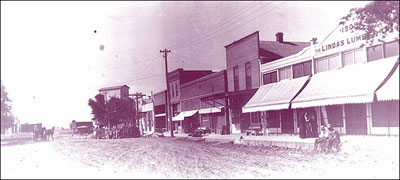
[December 3] Don Ross of Dodge City sent this photo of Pawnee Rock during a boom time in the early 20th century. It was a view I had never seen before, and I am glad to pass it along to everybody. Don had to do a bit of fancy darkroom work to make the print from the ancient negative made by a photographer who saved his life's work. (A negative that was much easier to print produced the photo of the Ben C. Unruh home.) Here's what he wrote: "This negative in bad shape. However, it shows the building next to J.L. Morris' store where most of us saw a vacant lot. Leon Miller mentioned it as vacant lot. "Whenever J.L. would have a piece of fruit or vegetable that was deteriorating to the point of no sale, he would throw it out in the vacant lot for the rabbits or cats or whatever. J.L. was a really nice guy. Always had a chew of tobacco in his mouth but you would never see him spit unless he was in the backroom. "The backroom is where he kept the kerosene and vinegar and other food products. The cookies were kept in glass front containers behind the counter, and he would always let you try one to see if that is the one you wanted to buy. "J.L. wore a white apron while at work and always looked as if he just got out of the bathtub. A good man he was. J.L. did well for himself. They said he came to town as a harvest hand. "Most of these negatives [including some of the Methodist Church] are around 1914 but not sure of this one. I got them from a photographer here in Dodge. His dad was photographer for the Daily Globe years back. It would be my guess that they were taken by an old-time photographer from Hanston, and when he closed his shop, the guy in Dodge got them some way or another." The piano recital [December 3] Anybody who used to be a child must remember the gut-tightening fear that accompanies the word "recital." Your recital might have come with singing lessons, or flute or trumpet lessons. My recital came with Mrs. Stansbury's piano lessons. Berdine (Mrs. George) Stansbury lived in a blonde brick ranch-style house along the asphalt road that led south from Pawnee Rock. Once a week, I pedaled my bike out to her place, my piano book inside a bag. My lessons went well enough for someone who didn't practice as much as he should have. For as much as I caught on to flats and sharps, I never solved the mystery of what my left hand should do while my right hand tickled the melody and pounded G-clef chords. (These days, I type like a virtuoso with both hands and I wonder whether I should try piano lessons again; I have some coordination that I lacked back then.) Sometime after I learned "Paladin" and church hymns, there came the recital. I think it was in the late winter or early spring of 1969, and we had weeks of warning, plenty of time for me to build up a sense of dread. I chose my music, or perhaps Mrs. Stansbury selected it for me. None of us kids wanted to disappoint Mrs. Stansbury, who was a nice woman but who had only a reasonable amount of patience. Nor did we want to make our parents think our tuition had been wasted. In Pawnee Rock, there weren't that many opportunities to do something special, even if we didn't recognize it at the time, and none of us wanted to prove that we couldn't learn when given the chance. And there were some girls who loved the piano and did quite well at it. The thin sun was shining on the day of the recital, but it was grim inside the living room. Chairs moved from the dining room held a couple of rows of parents and siblings facing the piano on the south wall, and a couch and end table filled the west wall across from the big window. Each student, maybe eight or ten of us, crabwalked among the chairs to the piano bench, our backs to the witnesses. I did my best. I played the right notes confidently and all the other notes just as loudly. My 4/4 rhythm probably was what I would later think of as a lurch. My parents and sister, Cheryl, clapped the longest. Mrs. Stansbury, I remember, smiled thinly as she thanked me and called for the next student. I stopped taking lessons within a month and thereafter concentrated on the trumpet. This past Saturday night, young Sam and Nik made their first public performances at the studio where they take guitar lessons. It was a Christmas party and potluck, and students were invited to bring their sheet music and play the piano or their guitars. The big room was packed with parents and kids, and there was a banquet of light foods. The instructors smiled with the kids and encouraged them gently. Everybody, from the bright-eyed girl who volunteered first for the piano to the seven-year-old who haltingly picked his way through "Jingle Bell Rock," got a full dose of applause and cheers. Sam and Nik practically pushed their way forward to play. Twice. The evening wasn't billed as a recital, just a chance for the kids to play if they wanted to. None of the parents was prompted to dredge up fears from their childhood recitals, although I bet I'm not the only one who did. Thank goodness we parents can learn to keep some things to ourselves. 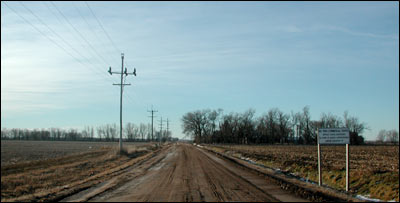
The former asphalt road leading south from the southwest corner of Pawnee Rock now is a dirt road. The Stansburys lived in the second house south, past the old Bowman/Pinkerton farmhouse inside the shelterbelt. Girls basketball: Cheryl Unruh has a photo and details of Pawnee Rock's first ninth-grade girls basketball team on her site, FlyoverPeople.net. Shorter wheat, better yield
Photo comparing the height of Larned and Turkey Red winter wheat varieties on a test plot near Larned, 1970s. [December 2] Leon Miller followed up on the photo of one of my sons acting like a farm kid a few years ago: "That's a beautiful picture of your son taken in the wheatfields. There's a little bit of irony here in that if the picture had been made 50 years earlier (1952) the tops of the wheat would have been at least 6" over his head. With the genetic engineering the stalks have been lowered and the amount of kernels in the head dramatically increased over the years. "My first year working in the harvest (1946) a 'bumper crop' was 20 bushels to the acre. Today, it's 3 times that amount. I have a niece in South Dakota who with her husband farm over 2,500 acres. They were getting 63 bushels of wheat to the acre this year. Times certainly have changed!" I wrote back that I had a photo of test plots showing Turkey Red wheat towering over a more recent (mid-1970s) variety. Turkey Red, of course, was the variety that started Kansas on its way to becoming the Breadbasket of the World about 135 years ago. "Is Turkey Red the same thing as Red Chief? That was the popular brand/type in the '40s & '50s. I remember that 1946 summer; it took 2 weeks to harvest Jess Franklin's 160 acres. I was driving his McCormick-Deering steel lug tractor pulling Jess on a 12' Gleaner Baldwin combine moving at about 5 mph. Today, a John Deere combine will move through that field in one morning, but it's probably going three times as fast and the cutter bar is three times as wide. Of course the Gleaner Baldwin combine was about $5,000.00 and today's John Deere runs about $250,000.00." A photo I like: No. 63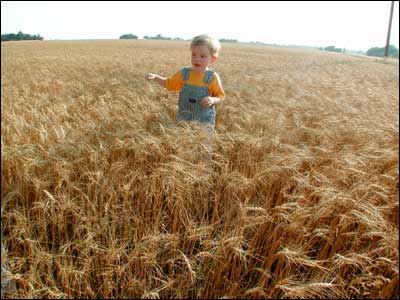
[December 1] Do you remember your first field of standing wheat, when you wandered out amid the scratchy stalks? Sure, you had walked through wheat stubble before during harvest, but this was different. This was fun. I made this photo on a trip to Pawnee Rock in 2002. The camera, facing toward the sun, saw a golden June evening, but Nik, with the sun at his back, saw the field with perfect clarity. Lois Becker: Lois Becker, the daughter of Cecil and Lela Holland Gilbert of Pawnee Rock, has died in Great Bend. She was 92 and had been born in Pawnee Rock in 1915. She married Harold Becker in 1936 the first recorded marriage on top of Pawnee Rock State Park. (Obituary) |
Sell itAdvertise here to an audience that's already interested in Pawnee Rock: Or tell someone happy birthday. Advertise on PawneeRock.org. |
|
|
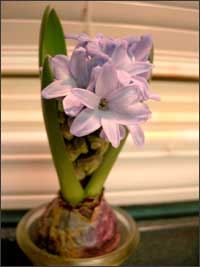 We tended our bulb, watching the white roots descend and the green leaves nudge their way out of the bulb. And just before Christmas, we got flowers: waxy, delightful light blue blossoms.
We tended our bulb, watching the white roots descend and the green leaves nudge their way out of the bulb. And just before Christmas, we got flowers: waxy, delightful light blue blossoms.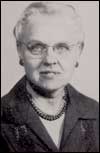 Sheila Sutton Schmidt: Sheila Sutton Schmidt taught in the Pawnee Rock schools for decades and then moved north. She and Harold (now deceased) lived in the Rock House northeast of town, where the Dale Unruh family now is.
Sheila Sutton Schmidt: Sheila Sutton Schmidt taught in the Pawnee Rock schools for decades and then moved north. She and Harold (now deceased) lived in the Rock House northeast of town, where the Dale Unruh family now is.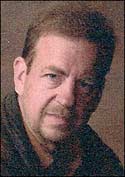 As
As 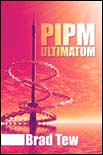 "PIPM Ultimatum" deals with a plan -- Planetary Improvement and Population Management -- to kill off most of the world's 12 billion people so that the remaining 2.4 billion can prosper in a world more like Eden. The way this works is that drug abusers, layabouts, and nonproductive people are subtly removed from society, and then more and more "good" people are taken as the years pass.
"PIPM Ultimatum" deals with a plan -- Planetary Improvement and Population Management -- to kill off most of the world's 12 billion people so that the remaining 2.4 billion can prosper in a world more like Eden. The way this works is that drug abusers, layabouts, and nonproductive people are subtly removed from society, and then more and more "good" people are taken as the years pass.